ECU Citroen C3 PICASSO RHD 2016 1.G Owner's Guide
[x] Cancel search | Manufacturer: CITROEN, Model Year: 2016, Model line: C3 PICASSO RHD, Model: Citroen C3 PICASSO RHD 2016 1.GPages: 296, PDF Size: 9.13 MB
Page 159 of 296
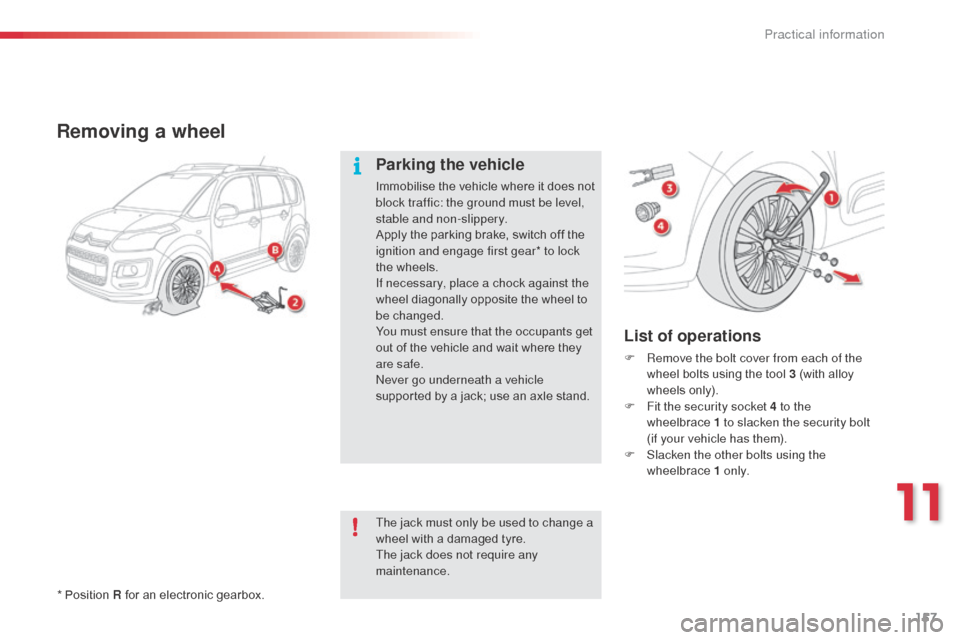
157
Removing a wheel
List of operations
F Remove the bolt cover from each of the wheel bolts using the tool 3 (with alloy
wheels only).
F
F
it the security socket 4 to the
wheelbrace
1
to slacken the security bolt
(if your vehicle has them).
F
S
lacken the other bolts using the
wheelbrace 1 o n l y.
Parking the vehicle
Immobilise the vehicle where it does not
block traffic: the ground must be level,
stable and non-slippery.
Apply the parking brake, switch off the
ignition and engage first gear* to lock
the wheels.
If necessary, place a chock against the
wheel diagonally opposite the wheel to
be changed.
You must ensure that the occupants get
out of the vehicle and wait where they
are safe.
Never go underneath a vehicle
supported by a jack; use an axle stand.
* Position R for an electronic gearbox. The jack must only be used to change a
wheel with a damaged tyre.
The jack does not require any
maintenance.
11
Practical information
Page 161 of 296
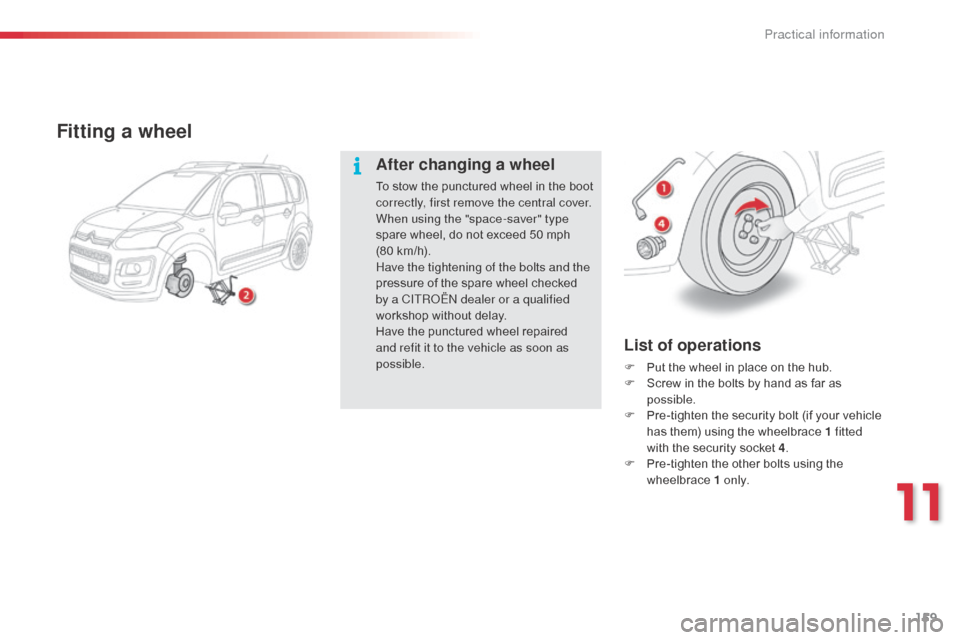
159
List of operations
F Put the wheel in place on the hub.
F S crew in the bolts by hand as far as
possible.
F
P
re-tighten the security bolt (if your vehicle
has them) using the wheelbrace 1 fitted
with the security socket 4 .
F
P
re-tighten the other bolts using the
wheelbrace 1 o n l y.
Fitting a wheel
After changing a wheel
To stow the punctured wheel in the boot
correctly, first remove the central cover.
When using the "space-saver" type
spare wheel, do not exceed 50 mph
(80
km/h).
Have the tightening of the bolts and the
pressure of the spare wheel checked
by a CITROËN dealer or a qualified
workshop without delay.
Have the punctured wheel repaired
and refit it to the vehicle as soon as
possible.
11
Practical information
Page 162 of 296
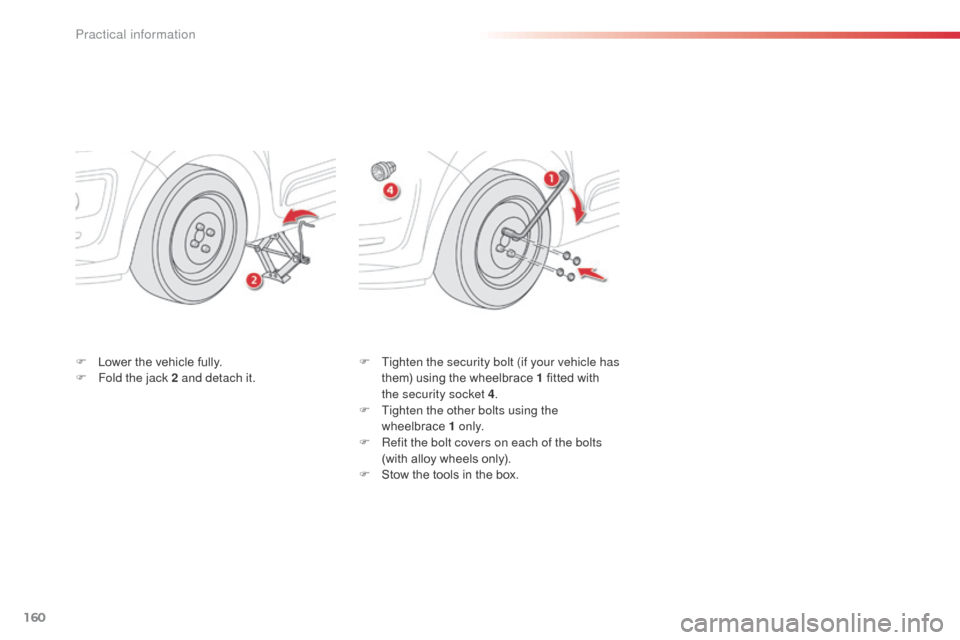
160
F Tighten the security bolt (if your vehicle has them) using the wheelbrace 1 fitted with
the security socket 4 .
F
T
ighten the other bolts using the
wheelbrace 1 o n l y.
F
R
efit the bolt covers on each of the bolts
(with alloy wheels only).
F
S
tow the tools in the box.
F
L
ower the vehicle fully.
F
F
old the jack 2 and detach it.
Practical information
Page 186 of 296
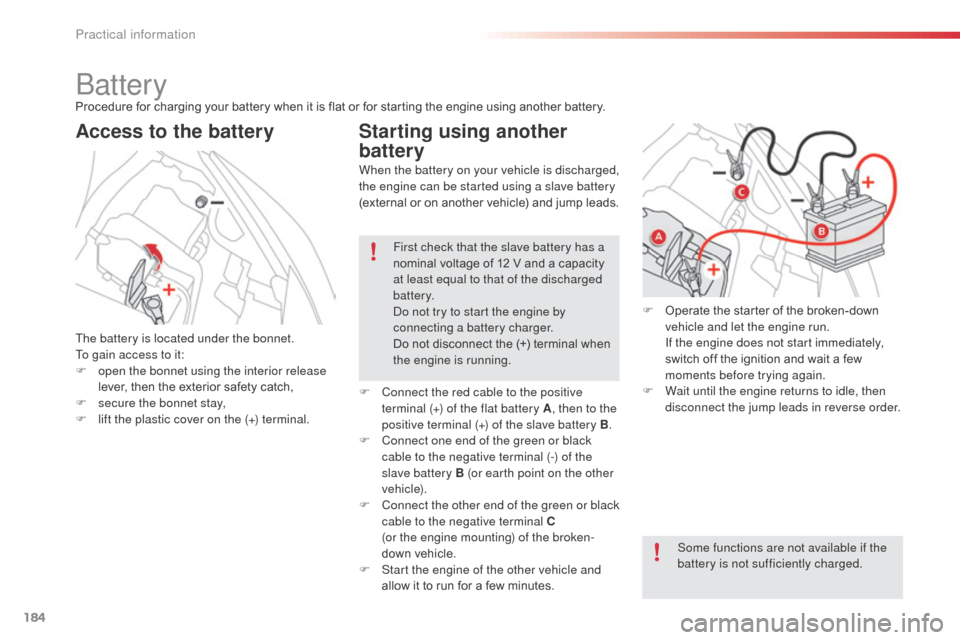
184
BatteryProcedure for charging your battery when it is flat or for starting the engine using another battery.
Access to the battery
The battery is located under the bonnet.
To gain access to it:
F
o
pen the bonnet using the interior release
lever, then the exterior safety catch,
F
s
ecure the bonnet stay,
F
l
ift the plastic cover on the (+) terminal. First check that the slave battery has a
nominal voltage of 12 V and a capacity
at least equal to that of the discharged
battery.
Do not try to start the engine by
connecting a battery charger.
Do not disconnect the (+) terminal when
the engine is running.
F
C
onnect the red cable to the positive
terminal (+) of the flat battery A , then to the
positive terminal (+) of the slave battery B.
F
C
onnect one end of the green or black
cable to the negative terminal (-) of the
slave battery B (or earth point on the other
vehicle).
F
C
onnect the other end of the green or black
cable to the negative terminal C
(or the engine mounting) of the broken-
down vehicle.
F
S
tart the engine of the other vehicle and
allow it to run for a few minutes.
Starting using another
battery
When the battery on your vehicle is discharged,
the engine can be started using a slave battery
(external or on another vehicle) and jump leads.
F
O
perate the starter of the broken-down
vehicle and let the engine run.
I
f the engine does not start immediately,
switch off the ignition and wait a few
moments before trying again.
F
W
ait until the engine returns to idle, then
disconnect the jump leads in reverse order.
Some functions are not available if the
battery is not sufficiently charged.
Practical information
Page 194 of 296
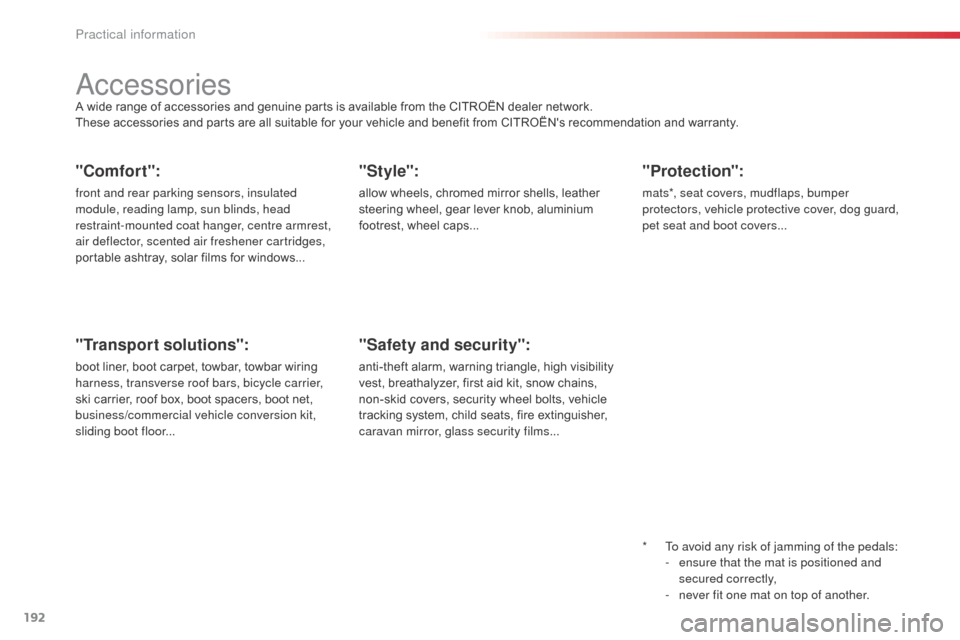
192
"Comfort":
front and rear parking sensors, insulated
module, reading lamp, sun blinds, head
restraint-mounted coat hanger, centre armrest,
air deflector, scented air freshener cartridges,
portable ashtray, solar films for windows...
"Protection":
mats*, seat covers, mudflaps, bumper
protectors, vehicle protective cover, dog guard,
pet seat and boot covers...
"Transport solutions":
boot liner, boot carpet, towbar, towbar wiring
harness, transverse roof bars, bicycle carrier,
ski carrier, roof box, boot spacers, boot net,
business/commercial vehicle conversion kit,
sliding boot floor...
"Safety and security":
anti-theft alarm, warning triangle, high visibility
vest, breathalyzer, first aid kit, snow chains,
non-skid covers, security wheel bolts, vehicle
tracking system, child seats, fire extinguisher,
caravan mirror, glass security films...
"Style":
allow wheels, chromed mirror shells, leather
steering wheel, gear lever knob, aluminium
footrest, wheel caps...
AccessoriesA wide range of accessories and genuine parts is available from the CITROËN dealer network.
These accessories and parts are all suitable for your vehicle and benefit from CITROËN's recommendation and warranty.*
T
o avoid any risk of jamming of the pedals:
-
e
nsure that the mat is positioned and
secured correctly,
-
n
ever fit one mat on top of another.
Practical information
Page 293 of 296
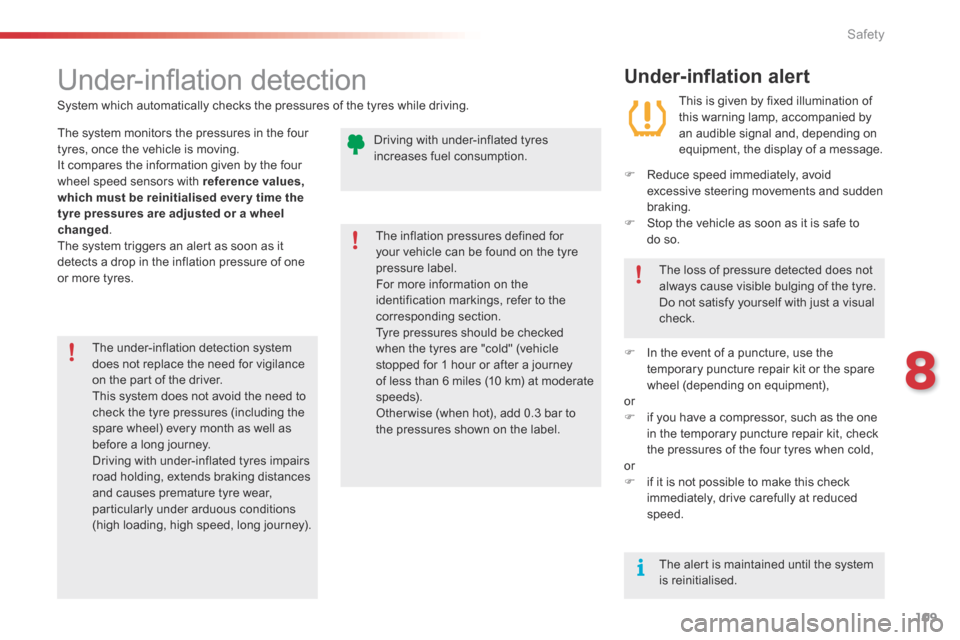
8
Safety109
C3Picasso_post-it_en_Chap08_securite_ed01-2015
U n d e r - i n fl a t i o n d e t e c t i o n
System which automatically checks the pressures of the tyres while driving.
The system monitors the pressures in the four tyres, once the vehicle is moving. It compares the information given by the four wheel speed sensors with reference values, which must be reinitialised ever y time the tyre pressures are adjusted or a wheel changed . The system triggers an alert as soon as it detects a drop in the inflation pressure of one or more tyres.
The under-inflation detection system does not replace the need for vigilance on the part of the driver. This system does not avoid the need to check the tyre pressures (including the spare wheel) every month as well as before a long journey. Driving with under-inflated tyres impairs road holding, extends braking distances and causes premature tyre wear, particularly under arduous conditions (high loading, high speed, long journey).
The inflation pressures defined for your vehicle can be found on the tyre pressure label. For more information on the identification markings, refer to the corresponding section. Tyre pressures should be checked when the tyres are "cold" (vehicle stopped for 1 hour or after a journey of less than 6 miles (10 km) at moderate speeds). Other wise (when hot), add 0.3 bar to the pressures shown on the label.
Driving with under-inflated tyres increases fuel consumption.
Under-inflation alert
This is given by fixed illumination of this warning lamp, accompanied by an audible signal and, depending on equipment, the display of a message.
Reduce speed immediately, avoid excessive steering movements and sudden braking. Stop the vehicle as soon as it is safe to
do so.
The loss of pressure detected does not always cause visible bulging of the tyre. Do not satisfy yourself with just a visual check.
The alert is maintained until the system is reinitialised.
In the event of a puncture, use the temporary puncture repair kit or the spare wheel (depending on equipment), or if you have a compressor, such as the one in the temporary puncture repair kit, check the pressures of the four tyres when cold, or if it is not possible to make this check immediately, drive carefully at reduced speed.
Page 294 of 296

Safety
110
C3Picasso_post-it_en_Chap08_securite_ed01-2015
Reinitialisation
It is necessary to reinitialise the system every time one or more tyre pressures are adjusted, and after changing one or more wheels.
Before reinitialising the system, ensure that the pressures of the four tyres are correct for the use of the vehicle and in line with the recommendations on the tyre pressure label. The under-inflation alert can only be relied on if the reinitialisation of the system has been done with the pressures in the four tyres correctly adjusted. The under-inflation detection system does not give a warning if a pressure is incorrect at the time of reinitialisation.
The system is reinitialised with the ignition on and the vehicle stationary, via the vehicle configuration menu.
Press the MENU button for access to the main menu. Press the " " or " " button to select the Veh conf ig menu, then confirm by pressing the OK button. Press the " " or " " button to select " Reinit inflat ", then confirm by pressing the OK button. Select " yes " or " no " then press OK . A message is displayed asking you to confirm the instruction. Confirm by pressing the OK button. Conform then quit the menu.
Press the MENU button for access to the main. Press the " " or " " button to select the menu, " Personalisation-configuration " then confirm by pressing the button OK . Press the " " or " " button to select the " Define vehicle parameters ", menu, then confirm by pressing the OK button. Press the " " or " " button to select the " Tyre pressures" , menu then the " Reinitialisation " menu, then confirm by pressing the OK button. A message confirms the reinitialisation.
The new pressure settings registered are considered to be reference values by the system.
Vehicles without audio or navigation system Vehicles with audio system
Page 295 of 296
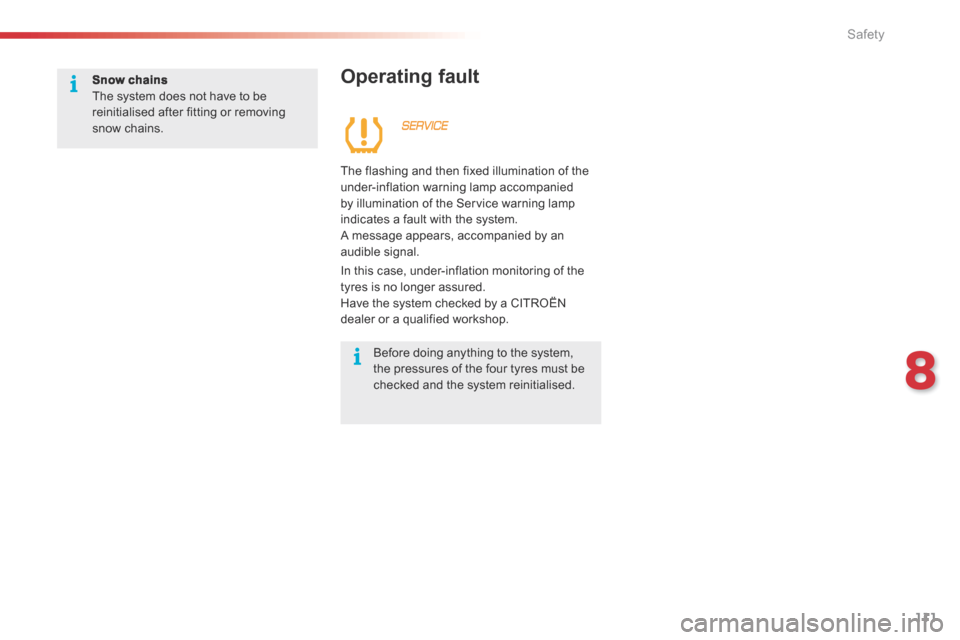
8
Safety111
C3Picasso_post-it_en_Chap08_securite_ed01-2015
Snow chains The system does not have to be reinitialised after fitting or removing snow chains.
Operating fault
The flashing and then fixed illumination of the under-inflation warning lamp accompanied by illumination of the Service warning lamp indicates a fault with the system. A message appears, accompanied by an audible signal.
In this case, under-inflation monitoring of the tyres is no longer assured. Have the system checked by a CITROËN dealer or a qualified workshop.
Before doing anything to the system, the pressures of the four tyres must be checked and the system reinitialised.